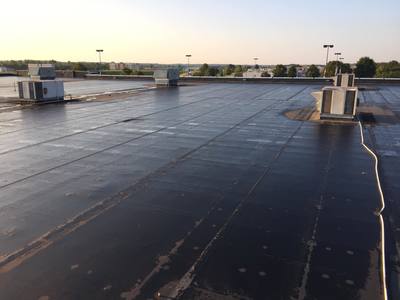Single-ply roofing is a popular choice for commercial and industrial buildings, as well as residential properties. In this blog post, we’ll take an in-depth look at the single-ply roofing system, including what it is, its brief history, types of single-ply, anatomy of an installed single-ply system, why single-ply is a superior commercial roofing system, energy savings benefits, and why single-ply is the most cost-effective option.
What is Single-ply Roofing?
Single-ply is a flat roofing system that uses a single layer of material to protect your property from the elements. The most common types of single-ply materials are thermoplastic membranes, such as PVC and TPO, and thermoset membranes, such as EPDM.
History of Single-ply Roofing
Single-ply was first introduced in the 1960s as an alternative to built-up roofing systems. It quickly gained popularity due to its ease of installation, durability, and cost-effectiveness.
The first introduction of single-ply roofing systems can be attributed to a few different companies and individuals. One of the earliest single-ply systems was developed by Carlisle Syntec Systems in the 1960s. This system, known as “Polyflex,” utilized a polyester reinforced PVC membrane, which was an innovation in the industry at that time.
The initial success of single-ply was due to its ease of installation, durability, and cost-effectiveness when compared to traditional built-up roofing systems. However, there were also some early failures of single-ply systems due to issues with material quality and installation practices.
Over time, the single-ply roofing industry has learned from its mistakes and has made improvements to the materials and installation practices. For example, manufacturers have developed newer and more advanced membranes that offer better performance characteristics and longer life expectancies. Additionally, there have been improvements in the way single-ply systems are designed and installed to ensure that they are more durable and long-lasting.
The industry has also developed and improved on the quality control measures, such as the testing and certification of the products, to ensure that the materials used are of high quality and are suitable for the intended use.
The introduction of single-ply systems in the 1960s revolutionized the roofing industry, it was an alternative to traditional built-up roofing systems. Its success was due to its ease of installation, durability, and cost-effectiveness. However, there were also some early failures, but over time the industry has learned from its mistakes and has made improvements to the materials and installation practices, making it a reliable and cost-effective option for commercial, industrial and residential properties.
Types of Single-ply Roofing
There are three main types of single-ply: PVC, TPO, and EPDM. PVC is a thermoplastic material that offers durability and resistance to chemicals and UV rays. TPO is a thermoplastic material that boasts high reflectivity and resistance to UV rays. EPDM, a thermoset rubber material, demonstrates flexibility and resistance to extreme temperatures.
Anatomy of an Installed Single-ply Roofing System
Single-ply systems use a single layer of material adhered or mechanically fastened to the roof deck to create a watertight barrier by sealing the edges and around penetrations. An insulation layer may also be added for energy efficiency.
Why Single-ply is a Superior Commercial Roofing System
Single-ply systems are durable and long-lasting, with life expectancies of up to 30 years or more. They are also easy to install, maintain, and repair, making them a cost-effective option for commercial properties.
Energy Savings Benefits of single-ply
Single-ply roofing systems are highly reflective, which helps to reduce the amount of heat absorbed by the building. This can lead to significant energy savings, particularly in warmer climates.
Why Single-ply Roofing is the Most Cost-effective Option
Single-ply systems are more cost-effective than other options, due to their ease of installation, durability, and low maintenance and repair costs. Additionally, single-ply systems can offer significant energy savings, which can offset the initial cost of the roofing system over time.
In summary, single-ply is an excellent choice for commercial and industrial buildings, as well as residential properties. It is a cost-effective and durable option that offers energy savings benefits. Single-ply is available in PVC, TPO, and EPDM materials, each with its own unique properties and advantages.
Below is a list of the nation’s top 8 single-ply manufacturers:
- GAF: https://www.gaf.com/
- Carlisle SynTec: https://www.carlislesyntec.com/
- Johns Manville: https://www.jm.com/en
- Firestone Building Products: https://www.firestonebpco.com/
- Sika Sarnafil: https://www.sarnafil.sika.com/
- CertainTeed: https://www.certainteed.com/commercial-roofing/
- Versico: https://www.versico.com/
- GenFlex: https://www.genflexroofing.com/



